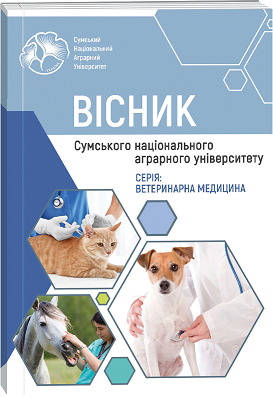EFFECT OF CIFLUTRIN-BASED DRUGS ON MORPHOLOGICAL AND BIOCHEMICAL PARAMETERS OF CATTLE BLOOD
Abstract
Cattle breeding is a branch of animal husbandry, which provides the population of Ukraine with indispensable animal proteins that are part of meat and dairy products. Unfortunately, the situation in cattle breeding in our country is critical, since in recent years there has been a rapid decline in the number of cattle in farms of various forms of ownership. Record low is the number of dairy animals, which requires the preservation and maintenance of the maximum epizootic well-being of the current livestock. One of the main factors in reducing the amount of products obtained are parasitic diseases, the causative agents of which are permanent or temporary ectoparasites. The main ectoparasites that attack cattle are lice and hairs, blood-sucking and non-blood-sucking insects, ixodes and sarcoptoid mites. After determining the effect of treatment of cattle of different age groups with preparations based on ciflutrin on morphological and biochemical parameters of blood was established. In cows treated with a drug based on ciflutrin, an increase in the number of red blood cells was noted. Accordingly, an increase in hemoglobin content was recorded in test cows by 10% (p < 0.001). There was also an increase in the number of red blood cells and hemoglobin content in the blood of calves of the experimental group by 21.8% (p < 0.001) and 7.4% (p < 0.01), respectively. Biochemical studies of treated serum showed a 1.1% increase in total protein in cows (p < 0.05) and a 15% increase in total protein in calves (p < 0.01). A 17% increase (p < 0.01) in carotene was recorded in the calf group. Studies have established a tendency to increase the alkaline reserve index during the experiment in all age groups. Therefore, the use of the drug based on the active ingredient cyfluthrin for insecticidal treatment of cattle did not cause changes in morphological and biochemical blood parameters beyond their reference values.
References
2. Berezovskyi, A. V., & Shevchenko, A. M. (2014). Diahnostyka, zakhody borotby ta zapobihannia entomoziv velykoi rohatoi khudoby. Metodychni rekomendatsii [Diagnosis, control measures and prevention of enteroses of cattle. Methodical recommendations.]. 32. [in Ukrainian].
3. Berezovskyi, A. V., Nahorna, L. V., & Proskurina, I. V. (2018). Osoblyvosti vykorystannia preparativ na osnovi tsyflutrynu dlia zakhystu khudoby vid litaiuchykh krovososiv. [Peculiarities of using preparations based on cyfluthrin to protect livestock from flying bloodsuckers]. Naukovo-tekhnichnyi biuleten instytutu biolohii tvaryn i DNDKI vetpreparativ ta kormovykh dobavok, 19(2), 193–198. [in Ukrainian].
4. Clausen, P. H., Stephan, A., Bartsch, S., Jandowsky, A., Hoffmann-Köhler, P., Schein E. (2009). Seasonal dynamics of biting midges (Diptera: Ceratopogonidae, Culicoides spp.) on dairy farms of Central Germany during the 2007/2008 epidemic of bluetongue. Parasitology Research, 105, 381–6. DOI:10.1007/s00436-009-1417-x
5. Colwell, D. D. (2014). Life history parameters of the cattle long-nosed sucking louse, Linognathus vituli. Medical and Veterinary Entomology, 5. 29.
6. Foster, A., Mitchell, S., & Wall, R. (2015). Cattle ectoparasites in Great Britain. Cattle Practice, 23(2), 280–287.
7. Guss, D. A., Koenig, M., & Castillo, E. M. (2011). Severe Iron Deficiency Anemia and Lice Infestation. The Journal of Emergency Medicine. 41(4). 362–365. DOI: 10.1016/j.jemermed.2010.05.030
8. Holmes, J. (2017). Managing External Parasites on Beef Cattle. Animal Industry News, 9, 1–4.
9. Kriukov, D. (2016). Borotba z komakhamy: khto peremahaie? [Fighting insects: who wins?]. Propozytsiia. 1. 60–63. [in Ukrainian].
10. Melo, R. M. P. dos S., Correia, T. R., Fernandes, J. I., & Scott, F. B. (2010). In vitro evaluation of a formulation with the pyrethroid cyfluthrin and the IGR pyriproxyfen on the control of Ctenocephalides felis felis (Bouché, 1835) (Siphonaptera: Pulicidae). Revista Brasileira de Medicina Veterinária, 32(1), 35–39.
11. Mullen, G. R., & Durden, L. A. (2019). Medical and Veterinary Entomology. Third ed. Philadelphia: Saunders, 792. DOI:10.1016/C2017-0-00210-0.
12. Nahorna, L. V., & Proskurina, I. V. (2018). Osoblyvosti insektytsydnykh obrobok u skotarstvi. [Peculiarities of insecticidal treatments in cattle breeding]. Mizhvidomchyi tematychnyi naukovyi zbirnyk. «Veterynarna medytsyna» NMTs «IEKVM», 104, 424–428. [in Ukrainian].
13. Otter, A. (2013). Diagnostic blood biochemistry and haematology in cattle. InPractice, 35(1), 7–16. DOI:10.1136/ inp.e871.
14. Otter, A., Twomey, D. F., Crawshaw, T. R., & Bates, P. (2003). Anaemia and mortality in calves infested with the long-nosed sucking louse (Linognathus vituli). Veterinary Record, 153(6), 176–179.
15. Poholivia koriv prodovzhuie aktyvno zmenshuvatysia (2023). [The number of cows continues to actively decrease]. URL: https://agronews.ua/news/pogolivya-koriv-prodovzhuye-aktyvno-skorochuvatysya/ [in Ukrainian].
16. Poholivia velykoi rohatoi khudoby prodovzhuie zmenshuvatysia (2023). [The number of cattle continues to decrease]. URL: https://avm-ua.org/uk/post/pogoliva-vrh-prodovzue-skorocuvatisa[in Ukrainian].
17. Proskurina, I., & Nahorna, L. (2021). Study of biological and ecological features of permanent ectoparasites of cattle. EUREKA: Health Sciences, 4, 101–108. doi: http://doi.org/10.21303/2504-5679.2021.001965
18. Rusak, V. S., & Chala, I. V. (2016). Klinichna otsinka biokhimichnykh, morfolohichnykh pokaznykiv krovi ta sechi tvaryn, navchalnyi posibnyk. [Clinical assessment of biochemical, morphological indicators of blood and urine of animals. Tutorial]. Zhytomyr: Polissia, 544. [in Ukrainian].
19. Sharif, A., Umer, M., & Ahmad, T. (2014). Parasitic control in dairy buffaloes. Int. J. Agric. Innov. Res, 2. 967–970.
20. Singh, J., Gupta, S. K., Singh, R., & Hussain, S. A. (2014). Etiology and haemato-biochemical alterations in cattle of Jammu suffering from anaemia. Veterinary World, 7(2), 49.
21. Wall, R., & Shearer, D. (1997). Veterinary entomology: arthropod ectoparasites of veterinary importance. Veterinary Parasitology, 99–116.
22. Zhyhaliuk, S. V. (2016). Mozhlyvosti vykorystannia insekto-akarytsydiv dlia sanatsii tvarynnytskykh prymishchen u prysutnosti poholivia (ohliadova stattia). [Possibilities of using insectoacaricides for the sanitation of livestock premises in the presence of livestock (review article)]. Veterynarna biotekhnolohiia, 28, 68–78. [in Ukrainian].
23. Zmenshylos poholivia koriv u hospodarstvakh (2023). [The number of cows on farms is decreasing]. URL: https:// kurkul.com/news/33527 [in Ukrainian].

 ISSN
ISSN  ISSN
ISSN 



